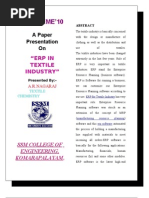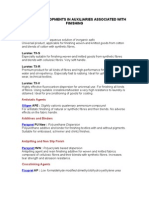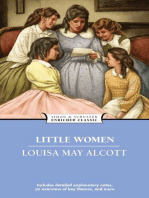0 ratings0% found this document useful (0 votes)
33 views8 Science Synthetic Fibres
8 Science Synthetic Fibres
Uploaded by
Harun VenkatCopyright:
Attribution Non-Commercial (BY-NC)
Available Formats
Download as PDF, TXT or read online from Scribd
8 Science Synthetic Fibres
8 Science Synthetic Fibres
Uploaded by
Harun Venkat0 ratings0% found this document useful (0 votes)
33 views4 pagesCopyright
© Attribution Non-Commercial (BY-NC)
Available Formats
PDF, TXT or read online from Scribd
Share this document
Did you find this document useful?
Is this content inappropriate?
Copyright:
Attribution Non-Commercial (BY-NC)
Available Formats
Download as PDF, TXT or read online from Scribd
Download as pdf or txt
0 ratings0% found this document useful (0 votes)
33 views4 pages8 Science Synthetic Fibres
8 Science Synthetic Fibres
Uploaded by
Harun VenkatCopyright:
Attribution Non-Commercial (BY-NC)
Available Formats
Download as PDF, TXT or read online from Scribd
Download as pdf or txt
You are on page 1of 4
Finish Line & Beyond
SYNTHETIC FIBRES AND PLASTICS
Rayon Nylon Polyester Acrylic Plastic Biodegradable Vs Non-Biodegradable
www.excellup.com 2009 send your queries to enquiry@excellup.com
Finish Line & Beyond
Synthetic Fibres Synthesis means to make and synthetic means man-made, so man made fibres are called synthetic fibres. A synthetic fibre is also a chain of small units joined together. Each small unit is actually a chemical substance. Many such small units combine to form a large single unit called a polymer. The word polymer comes from two Greek words; poly meaning many and mer meaning part/unit. So, a polymer is made of many repeating units. Types of Synthetic Fibres A). Rayon Towards the end of the nineteenth century, scientists were successful in obtaining a fibre having properties similar to that of silk. Such a fibre was obtained by chemical treatment of wood pulp. This fibre was called rayon or artificial silk. Although rayon is obtained from a natural source, wood pulp, yet it is a man-made fibre. It is cheaper than silk and can be woven like silk fibres. It can also be dyed in a wide variety of colours. Rayon is mixed with cotton to make bed sheets or mixed with wool to make carpets. B). Nylon Nylon is another man-made fibre. In 1931, it was made without using any natural raw material (from plant or animal). It was prepared from coal, water and air. It was the first fully synthetic fibre. Nylon fibre was strong, elastic and light. It was lustrous and easy to wash. So, it became very popular for making clothes. We use many articles made from nylon, such as socks, ropes, tents, toothbrushes, car seat belts, sleeping bags, curtains etc. Nylon is also used for making parachutes and ropes for rock climbing. A nylon thread is actually stronger than a steel wire. C). Polyester and Acrylic Polyester is another synthetic fibre. Fabric made from this fibre does not get wrinkled easily. It remains crisp and is easy to wash. So, it is quite suitable for making dress material. Terylene is popular polyester. It can be drawn into very fine fibres that can be woven like any other yarn. PET is a very familiar form of polyester. It is used for making bottles, utensils, films, wires and many other useful products. We wear sweaters and use shawls or blankets in the winter. Many of these are actually not made from natural wool, though they appear to resemble wool. These are prepared from another type of synthetic fibre called acrylic. The wool obtained
www.excellup.com 2009 send your queries to enquiry@excellup.com
Finish Line & Beyond
from natural sources is quite expensive, whereas clothes made from acrylic are relatively cheap. They are available in a variety of colours. Synthetic fibres are more durable and affordable which makes them more popular than natural fibres. Characteristics of Synthetic Fibres Synthetic fibres possess unique characteristics which make them popular dress materials. They dry up quickly, are durable, less expensive, readily available and easy to maintain. Plastics Plastic is also a polymer like the synthetic fibre. All plastics do not have the same type of arrangement of units. In some it is linear, whereas in others it is cross linked. Plastic articles are available in all possible shapes and sizes. The fact is that plastic is easily mouldable i.e. can be shaped in any form. Plastic can be recycled, reused, coloured, melted, rolled into sheets or made into wires. That is why it finds such a variety of uses. Some plastic articles can bend easily while some break when forced to bend. When we add hot water to a plastic bottle, it gets deformed. Such plastic which gets deformed easily on heating and can be bent easily are known as thermoplastics. Polythene and PVC are some of the examples of thermoplastics. These are used for manufacturing toys, combs and various types of containers. On the other hand, there are some plastics which when moulded once, can not be softened by heating. These are called thermosetting plastics. Two examples are bakelite and melamine. Bakelite is a poor conductor of heat and electricity. It is used for making electrical switches, handles of various utensils, etc. Melamine is a versatile material. It resists fire and can tolerate heat better than other plastics. It is used for making floor tiles, kitchenware and fabrics which resist fire. The characteristic properties of plastics. A). Plastic is non-reactive We know that metals like iron get rusted when left exposed to moisture and air. But plastics do not react with water and air. They are not corroded easily. That is why they are used to store various kinds of material, including many chemicals. B). Plastic is light, strong and durable Since plastic is very light, strong, and durable and can be moulded into different shapes and sizes, it is used for various purposes. Plastics are generally cheaper than metals. They are widely used in industry and for household articles.
www.excellup.com 2009 send your queries to enquiry@excellup.com
Finish Line & Beyond
C). Plastics are poor conductors Plastics are poor conductors of heat and electricity. That is why electrical wires have plastic covering, and handles of screw drivers are made of plastic. Plastics and the Environment A material which gets decomposed through natural processes, such as action by bacteria, is called biodegradable. A material which is not easily decomposed by natural processes is termed as non-biodegradable. Since plastic takes several years to decompose, it is not environment friendly. It causes environmental pollution. Besides, the burning process in the synthetic material is quite slow and it does not get completely burnt easily. In the process it releases lots of poisonous fumes into the atmosphere causing air pollution.
Type of waste
Approximate time taken to degenerate 1 to 2 weeks. 1030 days 2 to 5 months 10 to15 years About a year 100 to 500 years Several years
Nature of material
Peels of vegetable and fruits, leftover foodstuff, etc. Paper Cotton cloth Wood Woollen clothes Tin, aluminums, and other metal cans Plastic bags
Biodegradable Biodegradable Biodegradable Biodegradable Biodegradable Non-biodegradable Non-biodegradable
www.excellup.com 2009 send your queries to enquiry@excellup.com
You might also like
- The Subtle Art of Not Giving a F*ck: A Counterintuitive Approach to Living a Good LifeFrom EverandThe Subtle Art of Not Giving a F*ck: A Counterintuitive Approach to Living a Good LifeRating: 4 out of 5 stars4/5 (6023)
- The Gifts of Imperfection: Let Go of Who You Think You're Supposed to Be and Embrace Who You AreFrom EverandThe Gifts of Imperfection: Let Go of Who You Think You're Supposed to Be and Embrace Who You AreRating: 4 out of 5 stars4/5 (1132)
- Never Split the Difference: Negotiating As If Your Life Depended On ItFrom EverandNever Split the Difference: Negotiating As If Your Life Depended On ItRating: 4.5 out of 5 stars4.5/5 (910)
- Grit: The Power of Passion and PerseveranceFrom EverandGrit: The Power of Passion and PerseveranceRating: 4 out of 5 stars4/5 (628)
- Hidden Figures: The American Dream and the Untold Story of the Black Women Mathematicians Who Helped Win the Space RaceFrom EverandHidden Figures: The American Dream and the Untold Story of the Black Women Mathematicians Who Helped Win the Space RaceRating: 4 out of 5 stars4/5 (937)
- Shoe Dog: A Memoir by the Creator of NikeFrom EverandShoe Dog: A Memoir by the Creator of NikeRating: 4.5 out of 5 stars4.5/5 (548)
- The Hard Thing About Hard Things: Building a Business When There Are No Easy AnswersFrom EverandThe Hard Thing About Hard Things: Building a Business When There Are No Easy AnswersRating: 4.5 out of 5 stars4.5/5 (358)
- Her Body and Other Parties: StoriesFrom EverandHer Body and Other Parties: StoriesRating: 4 out of 5 stars4/5 (831)
- Elon Musk: Tesla, SpaceX, and the Quest for a Fantastic FutureFrom EverandElon Musk: Tesla, SpaceX, and the Quest for a Fantastic FutureRating: 4.5 out of 5 stars4.5/5 (481)
- The Emperor of All Maladies: A Biography of CancerFrom EverandThe Emperor of All Maladies: A Biography of CancerRating: 4.5 out of 5 stars4.5/5 (275)
- The Little Book of Hygge: Danish Secrets to Happy LivingFrom EverandThe Little Book of Hygge: Danish Secrets to Happy LivingRating: 3.5 out of 5 stars3.5/5 (434)
- The Yellow House: A Memoir (2019 National Book Award Winner)From EverandThe Yellow House: A Memoir (2019 National Book Award Winner)Rating: 4 out of 5 stars4/5 (99)
- The World Is Flat 3.0: A Brief History of the Twenty-first CenturyFrom EverandThe World Is Flat 3.0: A Brief History of the Twenty-first CenturyRating: 3.5 out of 5 stars3.5/5 (2281)
- Devil in the Grove: Thurgood Marshall, the Groveland Boys, and the Dawn of a New AmericaFrom EverandDevil in the Grove: Thurgood Marshall, the Groveland Boys, and the Dawn of a New AmericaRating: 4.5 out of 5 stars4.5/5 (273)
- The Sympathizer: A Novel (Pulitzer Prize for Fiction)From EverandThe Sympathizer: A Novel (Pulitzer Prize for Fiction)Rating: 4.5 out of 5 stars4.5/5 (125)
- A Heartbreaking Work Of Staggering Genius: A Memoir Based on a True StoryFrom EverandA Heartbreaking Work Of Staggering Genius: A Memoir Based on a True StoryRating: 3.5 out of 5 stars3.5/5 (233)
- Team of Rivals: The Political Genius of Abraham LincolnFrom EverandTeam of Rivals: The Political Genius of Abraham LincolnRating: 4.5 out of 5 stars4.5/5 (235)
- On Fire: The (Burning) Case for a Green New DealFrom EverandOn Fire: The (Burning) Case for a Green New DealRating: 4 out of 5 stars4/5 (75)
- The Unwinding: An Inner History of the New AmericaFrom EverandThe Unwinding: An Inner History of the New AmericaRating: 4 out of 5 stars4/5 (45)
- Syllabus For Textile Engineering and Fibre ScienceDocument3 pagesSyllabus For Textile Engineering and Fibre ScienceviveknarayanNo ratings yet
- Erp in TextileDocument15 pagesErp in TextileHarun VenkatNo ratings yet
- NRC Publications Archive (Nparc) Archives Des Publications Du CNRC (Nparc)Document11 pagesNRC Publications Archive (Nparc) Archives Des Publications Du CNRC (Nparc)Harun VenkatNo ratings yet
- Biosurfactants ReviewDocument12 pagesBiosurfactants ReviewHarun Venkat100% (1)
- ByravDocument18 pagesByravHarun VenkatNo ratings yet
- Third Internal TestDocument1 pageThird Internal TestHarun VenkatNo ratings yet














































